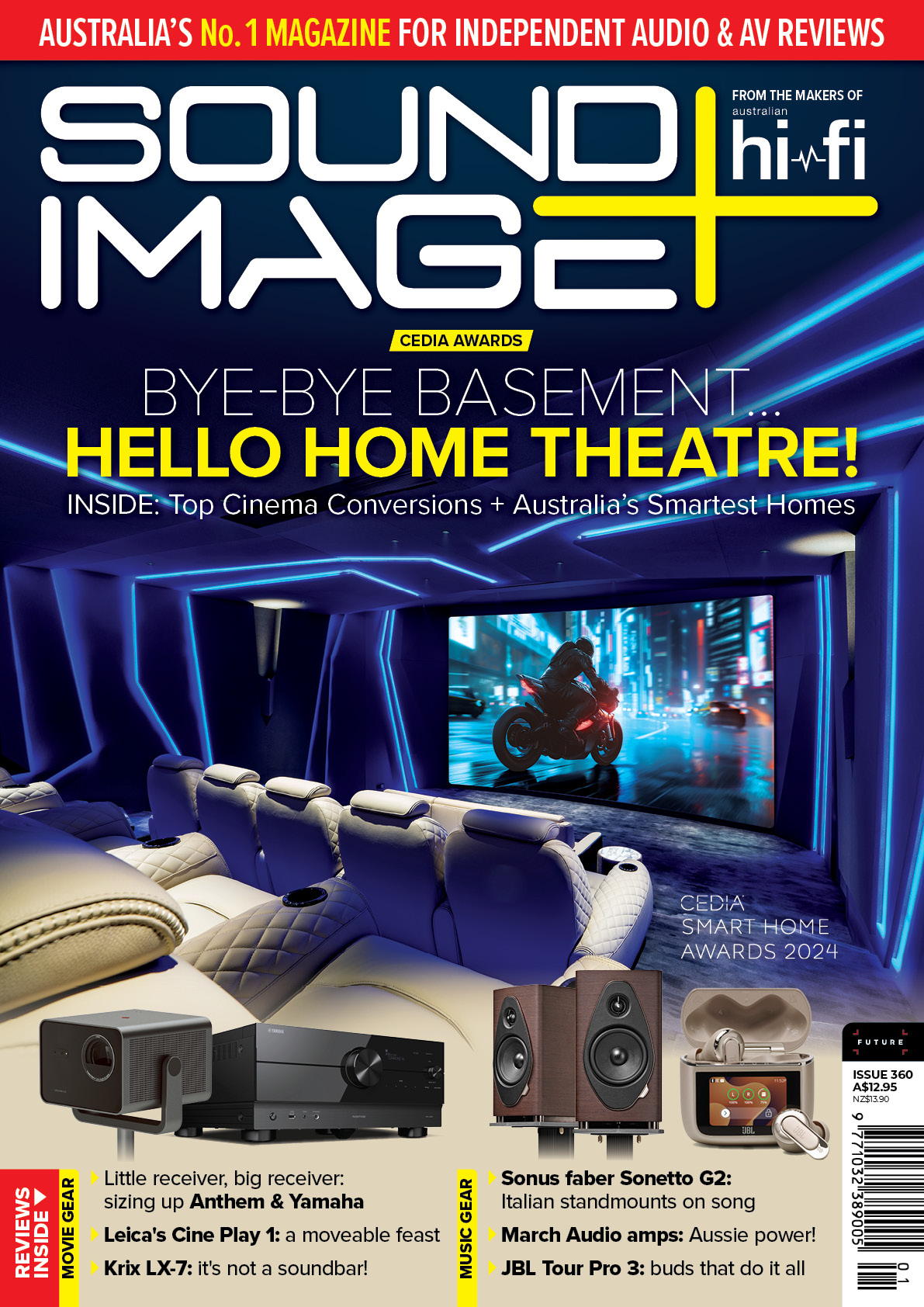Sound+Image Verdict
All three units in Denon's latest Home range of HEOS-equipped speakers have their place with their smart, multi-room integration and great audio, but the Home 250 is the Goldilocks of the bunch.
Pros
- +
Excellent sound from all three units
- +
Large & extended HEOS platform
- +
Voice control available from Google, Alexa or Siri
Cons
- -
Voice control requires separate device
Why you can trust What Hi-Fi?

This review originally appeared in Sound+Image magazine, one of What Hi-Fi?’s Australian sister publications. Click here for more information on Sound+Image, including details on how you can subscribe.
If you’ve heard of the HEOS wireless multiroom platform, well, this is its latest evolution in terms of standalone wireless speakers — a new three-strong range from Denon.
The HEOS platform allows music streaming to multiple rooms under a single app control, for both your own music collection and streaming services such as Spotify and Tidal.
So these speakers can work together with the whole HEOS ecosystem — which was originally developed in Australia (see below), and now includes soundbars, AV receivers, hi-fi systems and components.
These new speaker units take over from the longstanding HEOS-branded range, and move the focus away from the HEOS brand back to the company which created it, Denon.
Only the components — the HEOS Link and Amp and some more custom-orientated units — retain the HEOS branding; elsewhere HEOS becomes just another technology sticker on the box, though the platform remains as vital to their operation as ever.
Meet the family
The new three-strong wireless speaker includes, in rising order, the Home 150 (£219, US$249, AU$529), Home 250 (£449, US$499, AU$849) and Home 350 (£599, US$699, AU$1299).
Gone are the quirkily angular HEOS speaker designs; these are more straightforward boxes, each one a rectangular box with curved edges and a sturdy fabric wrap in a choice of black or white, though more accurately actually a light grey with white trimmings or a dark charcoal grey with black trimmings.
The smallest Home 150 is mono, with two drivers in a vertical 38cm-high case. The Home 250 is stereo with four active drivers and a passive bass radiator in a cabinet 30cm wide and a surprising 21.5cm high. The Home 350 is the largest, a substantial unit 38cm wide, 23cm high and 18cm deep.
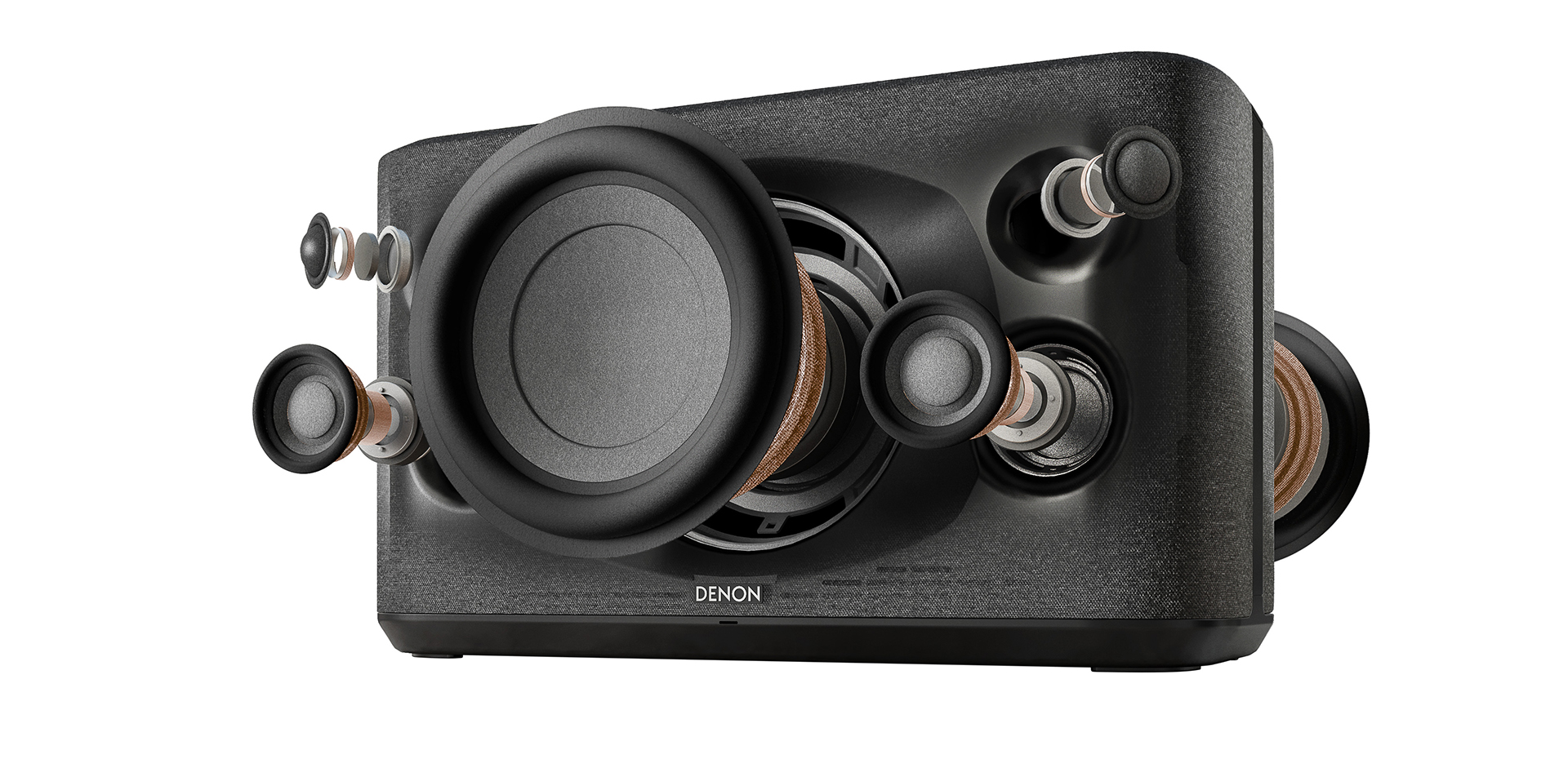
They are all HEOS-equipped, so that platform delivers full streaming access to online music services, network streaming from music shares up to high-res audio quality, and the ability to function in a multiroom system with other HEOS-equipped products.
The inclusion of AirPlay 2 means that they can do so also in an Apple home with other AirPlay 2 products, under Siri control, while the Home units are also addressable from Google Voice Assistant and Amazon Alexa devices — it’s good to see voice control being universally covered in this way, rather than sitting in one camp or another.
All three Denon Home speakers have the same connectivity — dual-band Wi-Fi, but also a physical Ethernet socket if preferred, plus a USB-A slot for playing files from a stick or hard drive, and a minijack analogue input. While you wouldn’t expect an optical digital input on the smallest Home 150, it might be considered an omission on the Home 350.
Another limited spec is Bluetooth, which mentions no codecs at all, so is likely limited to the base SBC, lacking even AAC to raise the quality from Apple devices, nor aptX for Android device users. But Apple users have AirPlay 2, and HEOS can play music on your device via the network anyway, so this will only affect the use of apps and services other than those directly accessible from within the HEOS app.
Set-up of each device requires plugging it in, then connecting to it from the HEOS app. Adding the Home 350 was a breeze, taking all of about a minute — Add Device, identify the speaker, press the Connect button on the back, and that was it. Not even a firmware update to sit through.
Not so the Home 150 and 250, which each had connection issues, the app failing to find either of them repeatedly from either an iPhone or an iPad Pro, so that we had to turn to the suggested alternatives, which involve either WPS button-press connection to your router, or giving the Home 150 an Ethernet connection via the supplied cable.
We had an Ethernet cable to hand, and once the Home 150 was networked it appeared in the app and could then be connected easily to the Wi-Fi. So while it’s frustrating when connections fail, the app walked us through alternate connection methods clearly and successfully.
The final connection method listed in the app is the one used by HEOS speakers, which involves connecting a minijack cable between the HEOS speaker and your device — but this isn’t available for the Home series, perhaps because ever fewer smart devices these days have headphone minijack sockets available for this method of connection.
We were interested to note that Mozilla (maker of the Firefox browser) is also somewhere inside, judging from an extra-ordinary eight pages of small print in the manual covering the rules of having its source code onboard the Home range.
The app
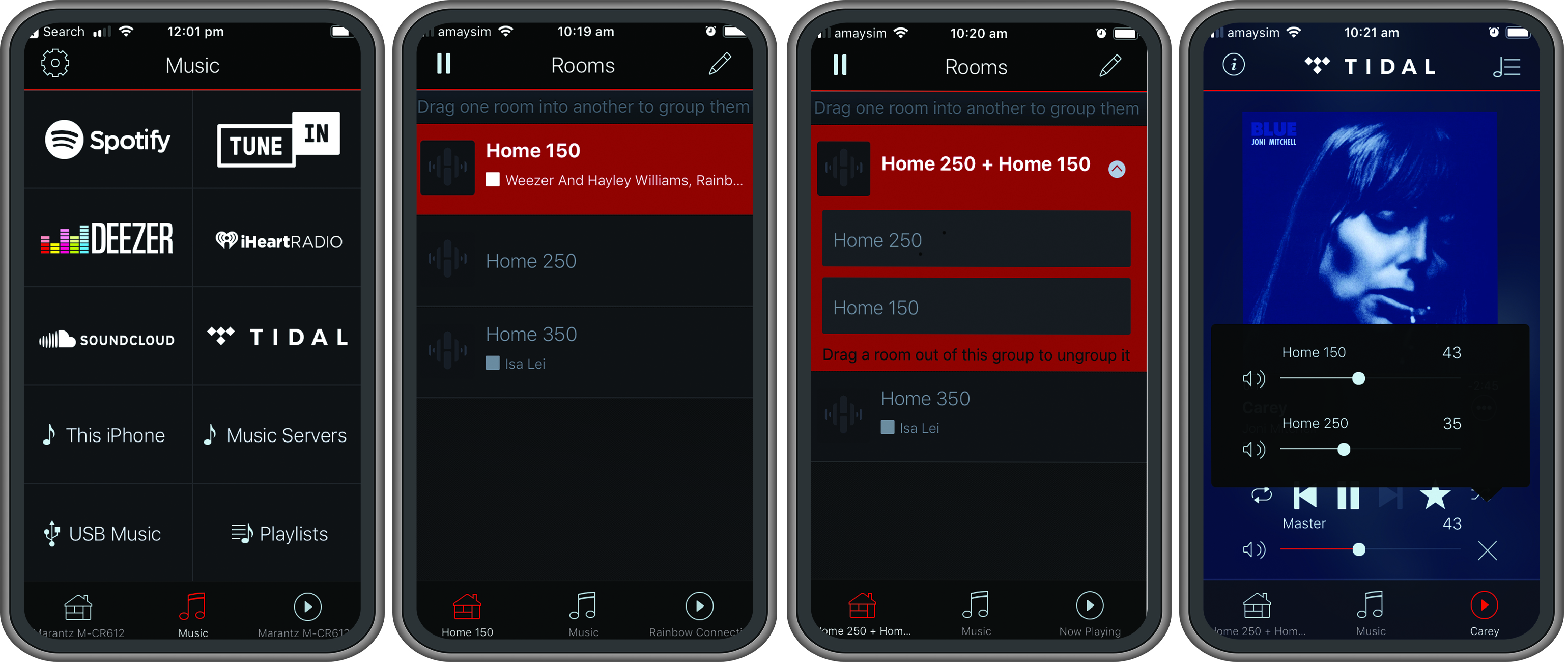
The Denon Home range uses the HEOS app for streaming and multiroom, and given that HEOS also appears in an extensive range of products from Denon and Marantz, these three speakers can become part of a multiroom system far beyond this Denon Home range.
The HEOS app is comprehensive and marvellously simple to use; in its earliest days we recall calling it perhaps oversimplified, but given the complexities and changes some rivals have since made, we happily withdraw that remark — the HEOS system with its three bottom navigation options gets you everywhere fast, while rapid access to the ‘Now playing’ screen makes transport and volume control easy, even in a multiroom context.
The only time you need to button mash is when you’re deep in a source’s menus — whether browsing Tidal or into the folder structure of a NAS drive, when to return to the main source menu you need to back up through all those layers.
It’s properly localised, too, so in Australia, for example, it offers Spotify Connect, Tidal, Deezer, iHeartRadio, TuneIn and Soundcloud as its default services (some rivals frustratingly offer lots of stuff available only in other markets). Stickers on the Home products note also Amazon Music HD, but that service is not yet available to Australia.
Below these services you can select ‘This iPhone’ (or whatever your device is), Music Servers, Playlists (made within the HEOS app; you can also queue music from different sources), History (very useful), and then physical inputs. In the case of the Home units these are USB and the analogue input.
With these inputs, the Denon Home range delivers an understated but potentially huge advantage over many competitors — they can broadcast these inputs to other Denon Home speakers. When using the Home 250, say, the HEOS app shows not only its own inputs but those of the Homes 150 and 350 on the same network.
So you could, for example, have a hard drive of music files attached to one unit and access them from all. A turntable attached (via a phono stage) to an input anywhere in the home can broadcast to a different speaker or all of them. This advantage of input forwarding can deliver much more music around the home.
Joining rooms for multiroom playback is simple — in the ‘Rooms’ page of the app you just drag device names together to form a group. You can rename a group, and when playing music you can access either a group volume control or individual sliders for each device. The effect of these sliders was immediate and accurate; some systems either lag badly or are plain old hard to control.
We find the HEOS app enjoyable and easy to use, especially as it doesn’t have the habit of some others in losing sight of the target device and having to reconnect each time you open the app. So although there’s no physical remote available or possible here, you miss it less than on those other systems.
So that’s the commonalities — let’s now check out the Home units one by one…
Denon Home 150
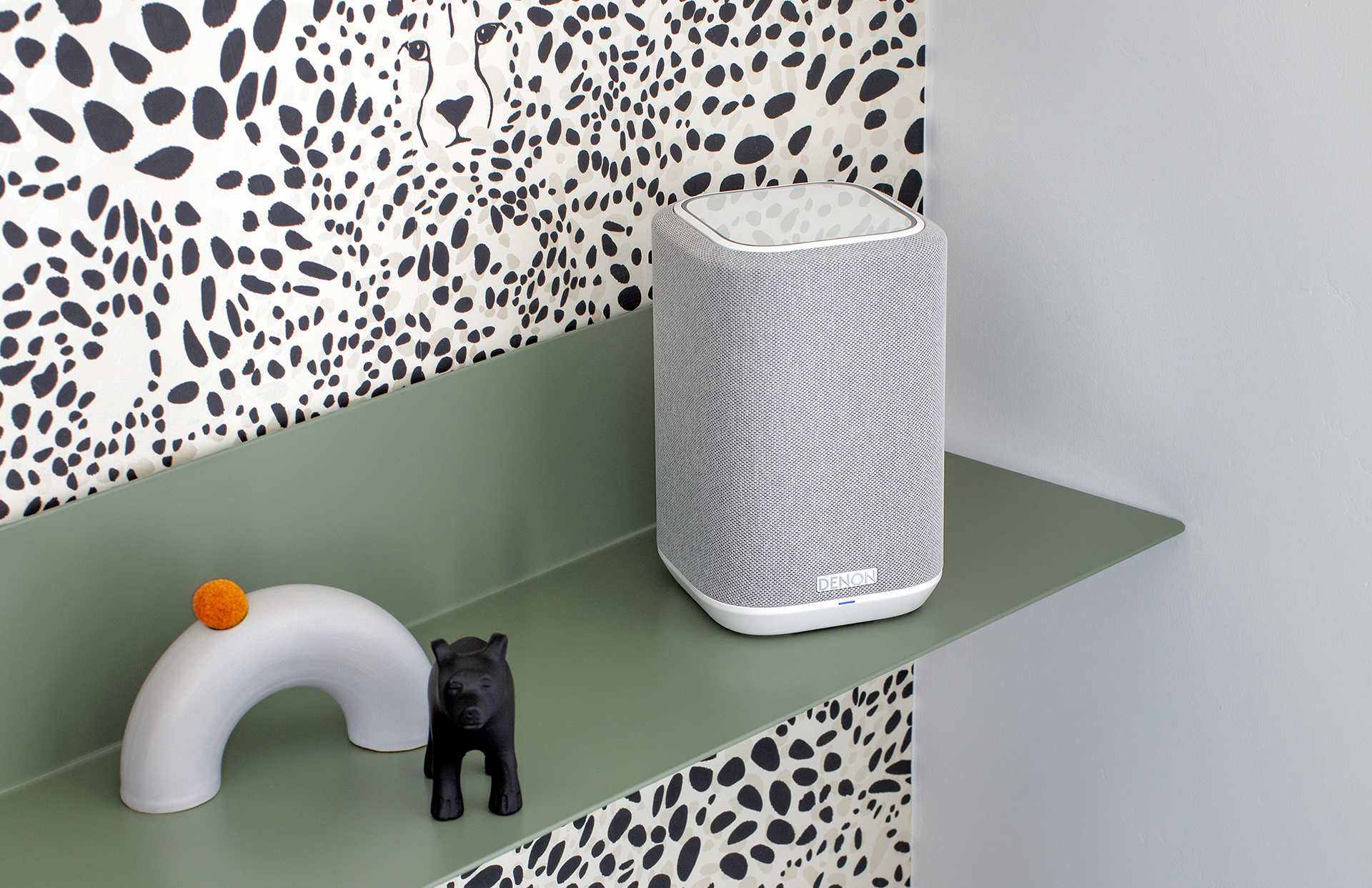
The Home 150 (£219, US$249, AU$529), is the smallest of the three wireless speakers, but still a solid and substantial object, with a 12cm-square footprint and 19cm height. The same sturdy fabric wrap covers three sides to meet at the back, where there’s a screw-threaded mounting hole should you wish to hang the 150 on a wall, and below that the indented connections panel offering a minijack auxiliary input, a USB-A slot and Ethernet networking. There are two buttons down there, one to launch Bluetooth pairing, and the other a ‘Connect’ button to connect the Home 150 with your HEOS app.
The reflective top surface illuminates as you approach to show more controls: three ‘input selection’ touch buttons, play/pause and volume control. Again, simple and intuitive.
It instantly impresses with scale and weight beyond the expectations of its size. It’s a mono speaker, boasting a single 25mm tweeter and an 89mm woofer, but it leverages these for a remarkably rich sound, even out in free space on a sturdy stand or table.
It was unexpectedly powerful as it kicked out an isolation-broadcast version of Crowded House’s Locked Out performed by Finn and family, drums to the fore with a solid kick-drum, the bass guitar forward and full and extended, plenty of drive and energy in the midrange to push forward guitars.
Yet it was equally impressive rendering the more delicate acoustic version of Message to My Girl which followed. Aside from a slight sibilance to vocal consonants, this sounds like the presentation from a speaker substantially larger, and it has an excitement, a punchy presentation akin to a mix which has been energised through a favourable dynamic limiter.
Ultimately its size and power have their limits at a point beyond which congestion and distortion become evident, but that point is impressively loud for a speaker so small. As for linearity, while its response to a sweep is less than smooth, with a notable push right down low then a dip from 60 to 100Hz, the balance is enjoyable in practice, spoken voices are tonally accurate, and there’s even a good sense of atmosphere around the different elements, an especially impressive achievement when working in mono. Positioning near a wall or a corner can enlarge the sound still more, at the cost of less predictable frequency response.
Some other multiroom systems offer useful battery operation for their smallest offering, making them a go-anywhere solution (though limited to Bluetooth or wired connections when away from the home network) — but that option is not available here.
However, as with all the Home range, the Denon 150 can be paired with another 150 to play in stereo; we did not have a second with which to try this, but we know the effect from many other systems is invariably still more impressive. And as with other multiroom systems, a pair of Denon Home 150s can be paired with a soundbar and subwoofer — here the DHT-S716H soundbar £799, US$899, AU$1699) and DSW-1H (£599, US$599, AU$1099) subwoofer — to create a 5.1-channel surround sound set-up.
Denon Home 250
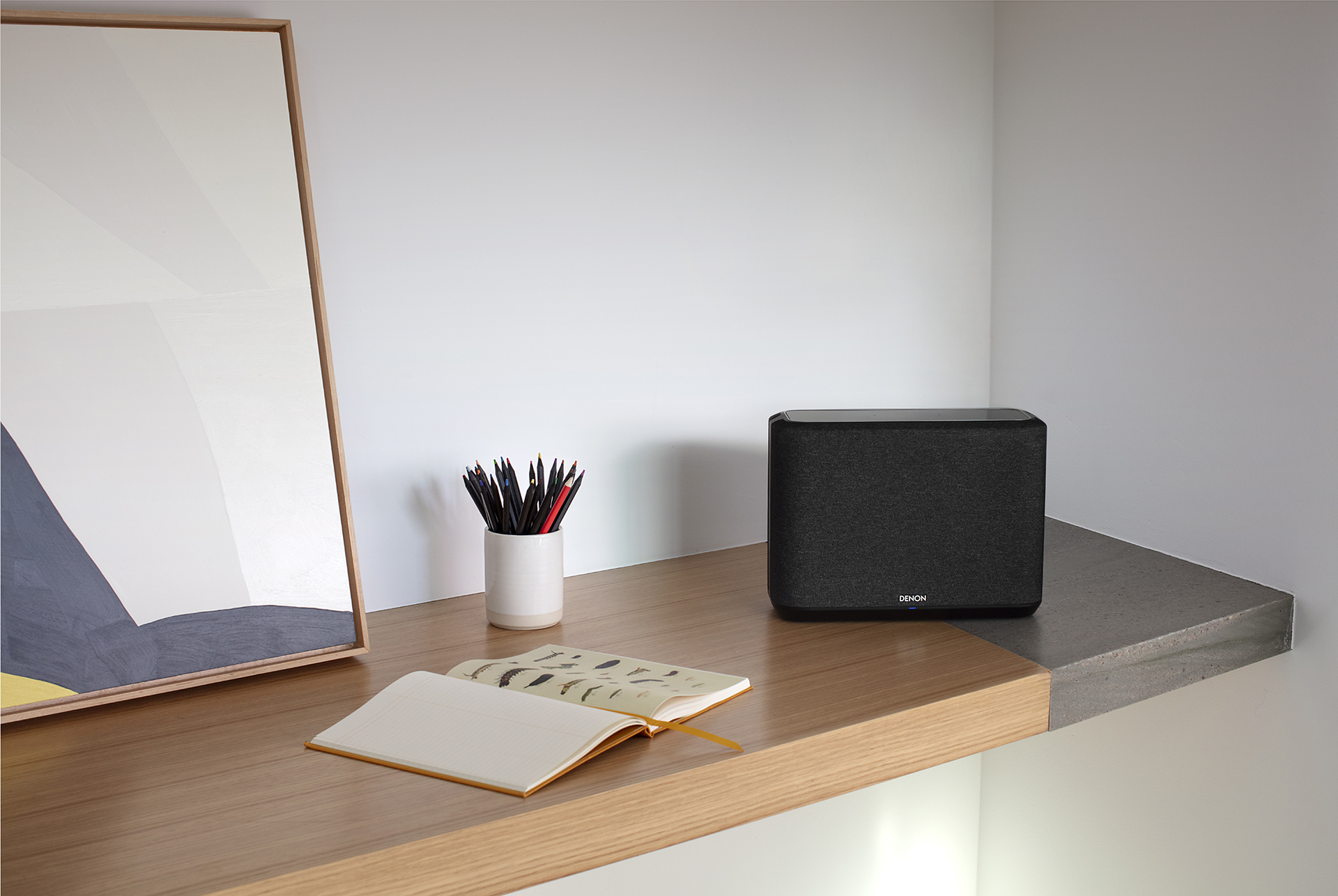
We thought the Home 250 (£449, US$499, AU$849) a slightly odd looker, still a straightforward curved box shape, yet presenting almost as much fascia to the user as the Home 350, while its alarming height of 20cm (compared to its width of 30cm) makes it look ungainly, even in the white (light grey) of our review unit. Still, the extra height allows a smaller footprint for its given volume, and the finish is as high quality as with the others.
We were nearly similarly rude about the sound of the Home 250 as well, given it was serving up a rather brash version of our music compared with either the 150 or 250. But we found that the unit’s EQ had arrived set, either by default or by a previous user, to bump up the bass and heavily push up the treble.
We zeroed both sliders and much preferred the less intrusive result — indeed once we settled into the sizeable sound the Home 250 proved the Goldilocks player of the three units, just as we always considered the middle HEOS 5 of the original range to be the sweet spot among HEOS-branded speakers.
This is a proper stereo speaker, having a pair of 19mm tweeters firing out at angles from the top corners of the front, supported by a pair of 10cm woofers firing directly forward. It has a secret bass weapon too, in a 133mm passive bass radiator which moves under the back pressure within the cabinet created by the active drivers, so delivering additional bass while also reducing the resistance against which the active drivers move. This passive driver faces backwards.
Even in free space the 250 can achieve a solid thump, though understandably with less depth than from the larger 350, the opening kick drum of Fleetwood Mac’s The Chain stopping short of the gut-thump which the larger speaker delivers.
The jazz band opening to Beyonce’s Daddy Lessons showed how at close range the true stereo is well spread, also how a favourable bass note can veritably boom forth, though its fundamental A and the adjacent G were significantly stronger than the C above or the F below; playing a test sweep there was an EQ push centred on 50Hz before the level backed off right up to 140Hz, hitting its full strength above 180Hz.
But that’s in free space, listening from a metre away without much room effect. Put the Home 250 nearer a wall and the rear passive radiator comes more into play, filling in the dip from 90Hz upwards, and facilitating a rather smoother and more solid sound. It was able
to deepen that Fleetwood Mac kick drum, though the Beyonce bassline remained uneven.
What the 250 gets very right is the confident way it rides the line between keeping things engaging in the treble and pushing too far into overbrightness, something it never did, even when pressed to pumping levels, even with our Dion torture test, where the overbright recorded vocal was nicely tamed, and the band filled out by that 50Hz notch up, one of the best deliveries of this difficult mix we’ve heard from any system, in fact.
Play a well-produced classic like Alan Parson Project’s The Raven and the 250 delivered a fine combination of nice warm bass line (coincidentally right on its preferred A) together with an excellent portrayal of the acoustic around the minimal drums of the second verse, the real and synthesised vocals kept clear and layered above, and the angled tweeters delivering the cymbal crashes in their stereo locations even when listening from a distance.
Come up to date with Tyler, The Creator’s EARFQUAKE and the 250 managed all three descending bass notes in quantity, just dropping away for the lowest D. Crucially, vocal tones weren’t thinned out in their lower regions, as we sometimes noted from the larger Home 350.
All in all, once we’d overcome our initial visual dislike of the tall design, which is, after all, eye-of-the-beholder stuff, we spent a happy week sending tunes through the Home 250. It gains enormously from the HEOS platform’s easy and extensive access to music, it multiroomed impeccably with the other Home speakers (and a visiting Marantz smart amp), and should prove a fine fit in any small/medium room, where it can go to a high proportion of its volume without fear of break-up.
Denon Home 350
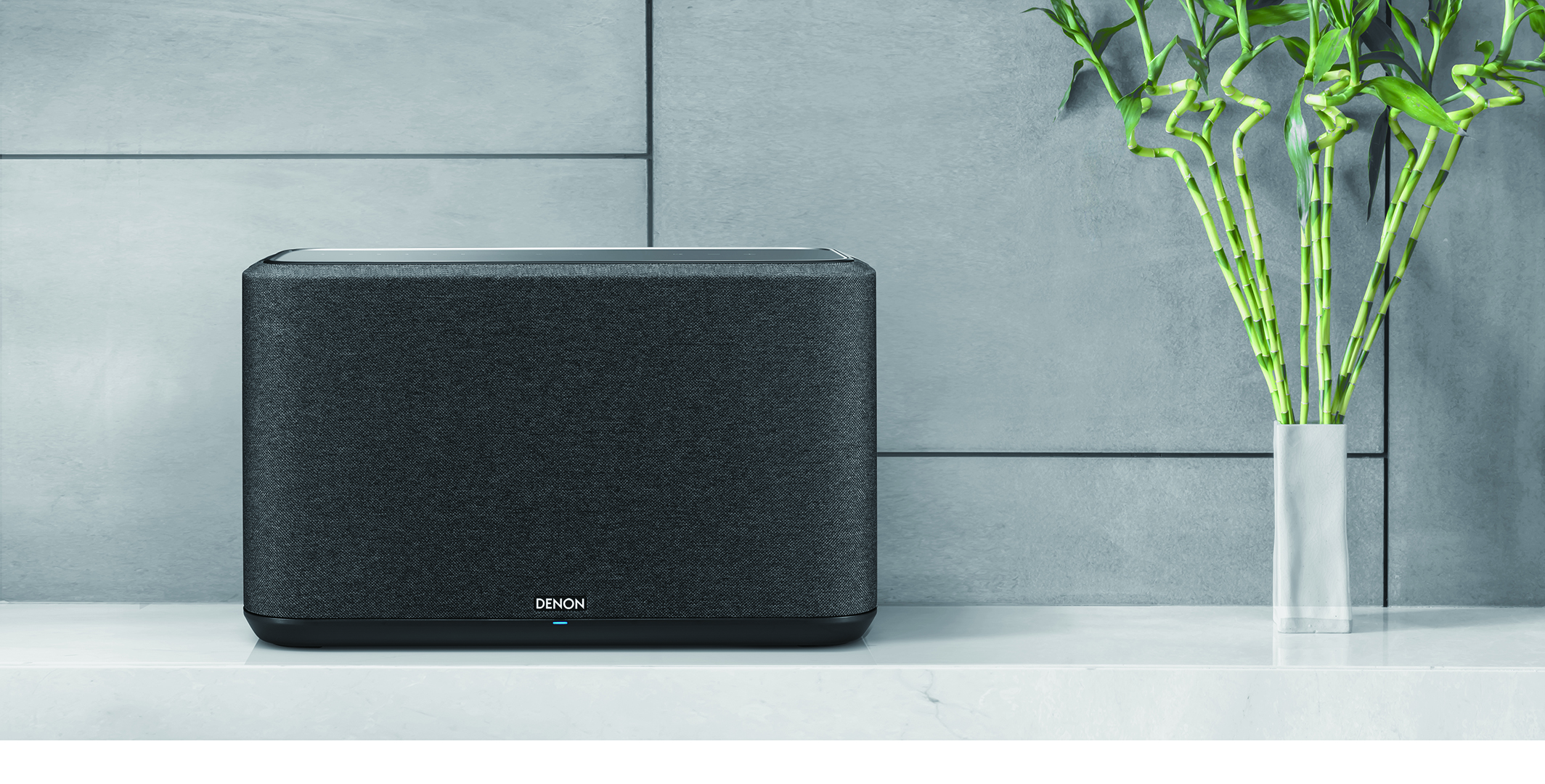
Operationally, the Home 350 (£599, US$699, AU$1299) was again first-class. With the HEOS app already loaded, adding the Home 350 took about a minute — Add Device, identify the speaker, press the Connect button on the back, and that was it. Not even a firmware update to sit through.
With set-up so rapid, we were quickly playing tunes, and were immediately impressed by the sheer size of its presentation. During warm-up we were regularly halted in other tasks, by the impact of the taut bass pedal on Fleetwood Mac’s The Chain, the pounding of drums and clack of sticks during Philip Glass’s Attack and Fall from ‘Akhenaten’.
Once we started critical listening, it was clear that much of the power behind these impressions came from a low bass of prodigious output. The bass on Stevie Wonder’s Living For The City descends deep in its closing seconds, and the Home 350 held each note steady and distinct down to the bottom F# — and for the bottom F for The Commodores’ Easy, though not the bottom D of Stereophile’s Organ Bass Tester track, putting the drop-off around 40Hz, with the region up to 100Hz fully delivered. This bass projects so distinctly it sometimes feels an additional component of depth sitting in front of a more radiogram delivery of the higher frequencies.
Finding some of our streaming Tidal Masters Motown list sounding surprisingly under-resolution in the quality of cymbals and strings, we used HEOS to stream our own trusted high-res collection from a NAS drive which resides in the basement. John Gorka’s The Gypsy Life, an AIX recording, did suffer an overemphasis of the low mids where male vocal resonance can reside — as in much throaty country and folk territory. This push notably blurred Gorkha’s vocal definition, and separated this region from the Home 150’s clear though isolated treble performance.
It became apparent that most of these bass characteristics were delivered by that rear-firing woofer, and its positioning as well as our position relative to the rear,greatly affected the balance. That organ bass test track positively throbbed from most positions in the room, but not from directly in front, with the Home 350 at eye and ear level, both at close quarters and to a lesser extent further away, as when we had it on a speaker stand in plenty of space.
(You might do adopt this arrangement if you took advantage of the ability to stereo pair two Home 350s.) From directly in front, bass frequencies sounded fairly balanced in the region above 100Hz, whereas from elsewhere in our room the combination of both bass drivers caused a frequency dip up to 140Hz, causing the separation of sound we were hearing. Different positioning and room shapes will change this unpredictably.
With the rear output firing more against a wall or corner, the uneven anomalies increased and the bass softened, but the sound became even more huge. It also retained its impressive sense of space. On a first-take bootleg of The Beatles Thank You Girl, the ping-pong left-channel drums were pushed by the angled drivers to a position wider than the box itself.
Playing against its rivals here, the spaciousness proved Denon’s main sonic advantage over a Naim Qb positioned alongside; switching between their two presentations of Walk on the Wild Side, the Qb’s sound was far boxier, relatively closed down up top, while the Home 350 clarified the shuffling rhythm and the consonants in the vocal, yet was not entirely natural, with a slight thinness from that dip in the local part of the vocal.
In contrast an also-resident B&W Wedge already had the openness to boast, and sounded more even — but with the Home 350 you gain the great merits of the HEOS app and the usefulness of external inputs in more easily accessing your music. And there’s always the top surface to use, which illuminates as you approach to show six user-definable preset buttons, plus play/pause and volume control. Again, these are simple and intuitive to use.
Undeniably powerful and musical, if slightly unpredictable because of that rear bass driver, the Home 350 is a solid performer to lead Denon’s new range.
Also compatible with...
Thanks to their inclusion of the HEOS platform the Denon Home range can group and communicate natively with a long list of Denon and Marantz products which carry the platform.
These range from the massive market-leading multichannel AV receivers made by both companies down through high-quality stereo amplifiers and on to neat little smart amps like the Marantz M-CR612 (known as the Melody X in some markets) which we had under review last issue, and which was still in residence when these Home units arrived. And, of course, any of the original HEOS range, which includes the HEOS Amp and the streaming add-on, the HEOS Link.
We’ve also seen (see Home 150 review) how Denon has rejigged two of its soundbars: the DHT-S716H (formerly the HEOS Bar) and the DHT-S516H (formerly the HEOS HS2, as well as the wireless active DSW-1H subwoofer, formerly the HEOS SUB. You can pair a couple of Home 150s to one of these soundbars (or a soundbar and subwoofer)
to enjoy a 5.1-channel surround package on special movie nights, while you can resituate the Home 150s the rest of the time as speakers in other rooms.
But there’s more, thanks to the inclusion of AirPlay 2, which allows Mac or Apple device owners to address the Denon Homes via that connection, which allows grouping with any other AirPlay-compatible speakers, as well as providing an endpoint for those who invest in Roon software.
And if you’re keen to use voice control, Denon’s Home speakers are able to be addressed via all three main methods — Google Assistant, Alexa and, via AirPlay 2, Siri. Alexa takes the most setting up, but they all worked well enough within their abilities.
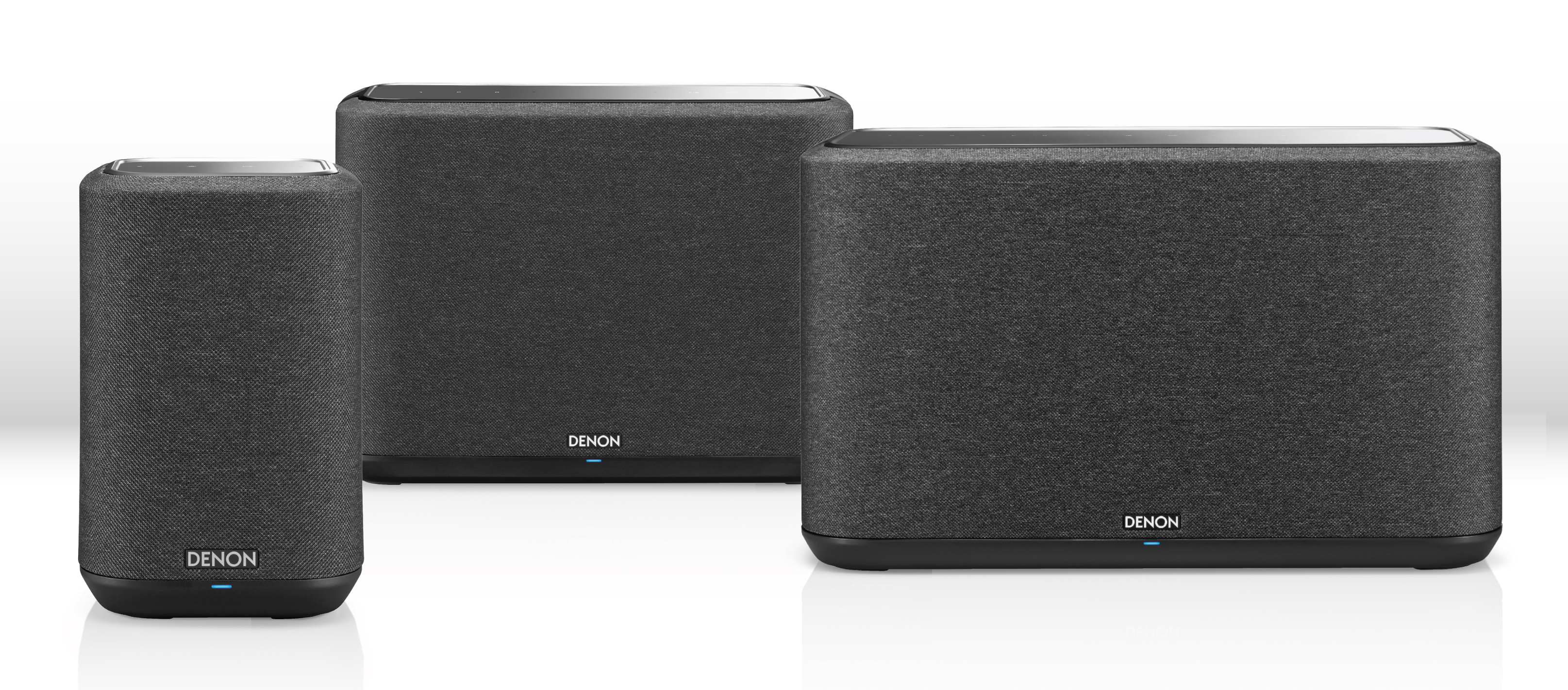
Developed in Australia
Australians may choose HEOS-equipped products with additional pride, knowing that HEOS had a significant part of its development Down Under, where a D&M Innovation Centre was tucked away in Berry Street, North Sydney.
The technology behind HEOS was born in Australia as the Avega system of wireless speakers going back almost a decade before HEOS. After being owned by radiata, cisco and Altec lansing, D&M “quietly made an offer” and acquired Avega and its technology in 2012, using the Australian team to develop the technology and the applications while using Denon’s wider expertise in cabinet design and audio tuning to create the original HEOS heos range.
Ongoing development continued with the original core ‘Avega’ team in North Sydney, along with a second Heos R&D Centre in California, and of course Denon in Japan.
Final verdict
With these three strong, musical and versatile smart speakers, together with a heap of existing HEOS family members, Denon’s Home series looks to be a true contender for your multiroom dollar if the cabinet design and pricing appeals. All three performed well, with the Home 250 proving a particular sonic sweetspot.
Sound+Image is Australia's no.1 mag for audio & AV – sister magazine to Australian Hi-Fi and to the UK's What Hi-Fi?, and bestower of the annual Sound+Image Awards, which since 1989 have recognised the year's best hi-fi and home cinema products and installations. While Sound+Image lives here online as part of our group, our true nature is best revealed in the print magazines and digital issues, which curate unique collections of content each issue under the Editorship of Jez Ford, in a celebration of the joys that real hi-fi and high-quality AV can bring. Enjoy essential reviews of the most exciting new gear, features on Australia's best home cinemas, advice on how to find your sound, and our full Buying Guide based on all our current and past award-winners, all wrapped up with the latest news and editorial ponderings. Click here for more information about Sound+Image, including links to buy individual digital editions and details on how best to subscribe.

